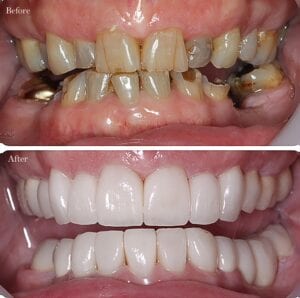5 Things Dental Crowns Can Fix

When it comes to restoring teeth, your dentist has a variety of options available to meet a range of needs. One common dental restoration in your dentist’s toolbox is the traditional dental crown. Traditional dental crowns are hollow caps made to look like teeth that fit over the top of an existing tooth in order to correct one or more of these common problems:

Decayed Teeth
One of the most common problems that dental crowns are used to fix are decayed teeth. Specifically, a dental crown may be appropriate in cases where a tooth contains a large amount of decay or when a tooth that already has a filling develops decay in a different area. Since decayed tissue needs to be removed and then weakens the tooth, dental crowns are often placed over the affected tooth in order to restore the tooth’s strength. They also protect the inside of the tooth from bacteria.
Damaged Teeth
Besides decay, the other problem that can affect the structural integrity of a tooth is damage. Teeth can become damaged for any number of reasons, whether they are healthy or not. Generally speaking, however, decayed teeth are more likely to become damaged. Much like a decayed tooth, if a tooth becomes chipped or cracked deep enough, then it is susceptible to future damage and decay. This is because bacteria can enter the tooth through chips and cracks. Therefore, dental crowns are placed over damaged teeth for the same reasons as they are placed on decayed teeth: to protect and strengthen the tooth.
Cosmetic Problems
Even when the teeth are not decayed or damaged, they can still have cosmetic flaws that you may not like. For example, some teeth become stained over time. Depending on the type of stain, teeth whitening procedures may not be effective. Therefore, the only way to whiten their teeth is through having a crown placed on one or more teeth. Teeth can also be oddly shaped, too small, or unevenly sized, all of which can make your smile look less-than-perfect. In these cases, dental crowns can be placed as part of a smile makeover.
An Uneven Bite
There are also cases where dental crowns can be placed as a way of making one’s bite more even. For example, if someone has multiple teeth that are not the same length, then their opposing teeth may not meet up properly and affect their entire bite. Not only can this make speaking and eating difficult, but it can also stress the temporomandibular joint and increase the risk of developing TMD later in life. Placing dental crowns helps to even out the teeth so that the upper and lower arch can meet up properly and evenly.
Sensitive Teeth
Tooth sensitivity is a dull, throbbing pain felt deep in the jaw when the teeth are exposed to hot, cold, or sweet. This occurs when the enamel is worn down and unable to prevent stimuli from entering the inside of the tooth. When stimuli enters the tooth, it irritates the nerve and causes the painful sensation known as tooth sensitivity. Placing a dental crown over the tops of sensitive teeth can eliminate tooth sensitivity since the crown will act as a protective barrier that prevents stimuli from entering the tooth and irritating the nerve.






Recent Comments